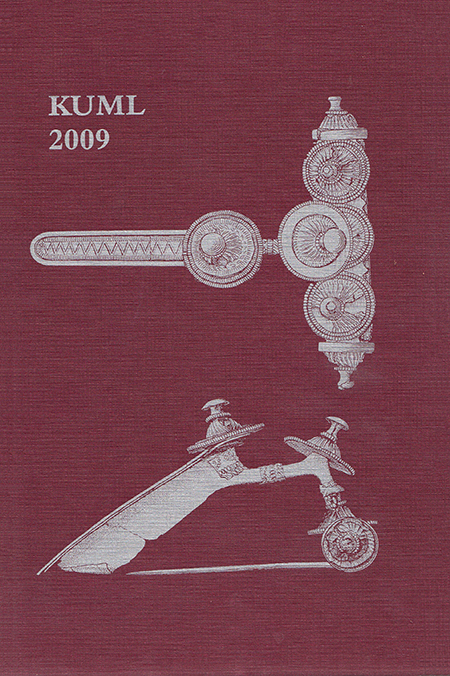Middelalderlige ringspænder – Typologi, datering og brug
DOI:
https://doi.org/10.7146/kuml.v58i58.26394Keywords:
Middelalder, ringspænderAbstract
Medieval ring brooches from Denmark – Typology, dating and useRing brooches are one of the most common types of jewellery from the Middle Ages. They consist of a closed frame with a fixed pin (fig. 1). The metal detector activity of recent years has increased the number of these brooches. They have not previously been dealt with separately in Denmark. This article is based on the collection and typological classification of 215 ring brooches from present-day Denmark. These brooches can be classified into seven types with 23 sub-types (fig. 2). Nine of the brooches have no Danish parallel. The frames are most often circular, but their form varies. The circular brooches (types 1-3) are the most common. They make up 83% of the Danish brooches, whereas other frame shapes are less common (fig. 3). The use of ring brooches arose simultaneously with the Byzantine fashion of dress from the 12th century. The fashion dictated long coats or kirtles for both sexes (fig. 4). The neck opening of the kirtles was equipped with a slit which was fastened with a ring brooch (fig. 5); the brooches were also used to fasten cloaks. The ring brooches can be dated to a period extending from the 12th century until some time in the 15th century. In the beginning, functionality had priority, but later ring brooches appeared which were solely for decoration or were used to attach other items to the clothing. Dating of the individual types is based on stylistic and archaeological criteria together with numismatic dates from hoards. The latter two dating methods in particular provide a narrower dating framework for some of the types; this applies to, for example, types 3 and 4.1 (fig. 8). The earliest example in Scandinavian art of the use of ring brooches is from around AD 1200 (fig. 15), whereas there are archaeological finds from Denmark from the second half of the 12th century. Fig. 8 provides an overview of Danish and foreign dates for the ring brooch types. Types 1 and 2 both occur in the 12th century, whereas the other types appear from the 13th century. Some of the types are seen across large parts of Europe. This applies, for example, to types 1.1, 1.3, 2.1 and 2.6. Others have a more limited geographical distribution, which reflects cultural and trade-related links. This applies to types 1.4, 2.5 and 3. Some brooches are unique to Denmark but all have parallels in other countries. This underlines the fact that there are, by and large, no unique brooches, but that they all have a greater or smaller distribution (figs. 12 and 13). The ring brooches are often made from various types of copper alloy, while precious metals are more rarely used (fig. 14). They occur in a series of social contexts and this underlines the applicability of this type of jewellery. Most of the types occur as precious metal as well as alloy, and the same decorative elements are seen on brooches of very different quality (figs. 7 and 10). Ring brooches were worn by both men and women and probably also by children. Their size can give an indication of who wore them and how. The visual arts are a good source in this respect (fig. 5). Other sources include wills and, in rare cases, inscriptions on the brooches themselves, revealing the sex of the person who wore them. The greatest diameter of the ring brooches lies typically between 20 and 29 mm. A group comprising 12 brooches differs in this respect, having a diameter of between 13 and 19 mm, and eight medium- sized brooches have a diameter of between 50 and 59 mm. A group comprising 10 brooches has diameters of between 60 and 96 mm. These large brooches were probably cloak-fasteners. Medieval jewellery was often associated with great symbolism. This could be through the material from which they were made, in the form of metal and precious or semi-precious stones which was ascribed special significance. The symbolic value becomes clearest through the many inscriptions of a religious or amorous nature (fig. 9). Ring brooches were, like finger rings, a symbol of fidelity and love, and their function as a fastener for a cloak became, in a figurative sense, a picture of chastity.
Mette Højmark Søvsø
Sydvestjyske Museer
Downloads
Published
2009-10-18
How to Cite
Søvsø, M. H. (2009). Middelalderlige ringspænder – Typologi, datering og brug. Kuml, 58(58), 183–211. https://doi.org/10.7146/kuml.v58i58.26394
Issue
Section
Articles
License
Fra og med årgang 2022 er artikler udgivet i Kuml med en licens fra Creative Commons (CC BY-NC-SA 4.0).
Alle tidligere årgange af tidsskriftet er ikke udgivet med en licens fra Creative Commons.


